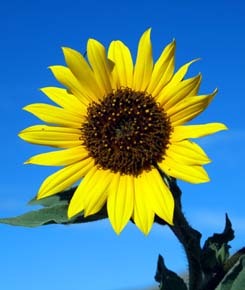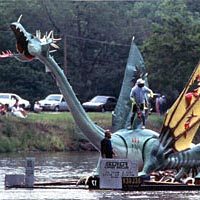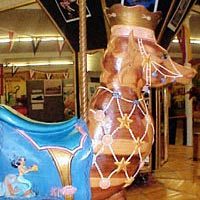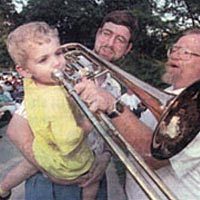
- Capital City:
- Topeka
- Nickname:
- Sunflower State
- Motto:
- Ad Astra per Aspera (To the stars through difficulties)
- Statehood:
- January 29, 1861 (34th)
- Origin of State's Name:
- From the Sioux Indian for "south wind people."
- Largest City:
- Wichita
- Border States:
- Colorado, Missouri, Nebraska, Oklahoma
- Land Area:
- 81,823 sq. mi., 13th largest
- State Bird:
- Western Meadowlark
- State Flower:
- Sunflower
- State Tree:
- Cottonwood (populus)
- State Song:
- Home on the Range
Known as the "Sunflower State," Kansas became the 34th state in 1861. The state's name comes from the Kansa or Kaw Indians and is a Sioux Indian term meaning "south wind people." Within Kansas's borders is the magnetic center mark for all of North America. All land surveys in the U.S., Canada, and Mexico use this as a reference point. The geographic center of the 48 contiguous (connected) states is located in a Kansas pasture. The native sunflower is the state flower and the capital is Topeka.
Wichita River Festival

This ten-day-long event, founded 28 years ago, has not only survived, but prospered. It features over 100 events, including live entertainment, cook-offs, a fishing derby, and canoe, automobile, and bathtub races. A mainstay of the Festival since 1976 is the Saturday morning raft race in which decorated rafts float down the winding Arkansas River, their occupants spraying the many spectators on the banks with river water. Festivities are concluded with a pops concert by the Wichita Symphony Orchestra and fireworks over the Arkansas River. First held in 1972, the festival is an outgrowth of the 1970 Wichita Centennial Celebration.
Midway USA: Kinsley, Kansas

Kinsley, Kansas, earned the name "Midway USA" by being exactly 1,561 from San Francisco to the west and 1,561 miles to New York in the east, inspiring a 1939 Saturday Evening Post cover showing two cars, starting in Kinsley and going in opposite directions, both bearing a sign saying "World's Fair or Bust." (In 1939, there were two "World's Fairs": an eponymous one in New York, and the Golden Gate Exposition in San Francisco.) Kinsley, a small community with less than 2,000 residents, is set in a region of prime agricultural land supporting wheat, corn, soybean and cattle production.
In 1901, Kinsley area farmer Charles Brodbeck, ventured to Hutchinson, Kansas, a journey of almost one hundred miles. There he was fascinated by a small cable-driven carousel, but more fascinated that people would ride a horse a considerable distance and then pay someone a nickel to ride a wooden horse around in circles. Brodbeck traded a quarter acre of land, some horses and cows for the little carousel. Brodbeck at first kept the carousel at his farm and gave rides to the neighbors, but, in 1908, he and his son Fred loaded up the carousel and took it to nearby towns to sell rides. Very soon the family concluded that the little carousel with the wooden horses going round in a circle could make more money than farming. The next year, the family went out with the carousel and offered rides at small town fairs and picnics throughout south central Kansas, and added a Ferris Wheel, one of the first commercial ones in the nation.
Clearly there was money to be made in the carnival amusement business and there was a great need for family entertainment in the small towns of the Midwest. Rides were added, games and exhibitions were added, and soon the traveling carnival became a full-fledged "show." Brodbeck was unable to meet the demands of towns that wanted a carnival, and involved the rest of his family in the carnival business. Each carnival would hire local workers to set up and tear down the shows, and concessionaires to sell popcorn, sno cones, and run penny arcades.
From the early part of the 20th century through the 1970s, the carnivals of Kinsley would travel throughout the Midwest from April to October setting up amusements for the delight of young and old. By the late 1970s, the costs of liability insurance, overhead and finding reliable employees made the operation of the smaller family carnivals difficult. Very large carnival companies began to serve big events like State Fairs and large expositions.
The rich carnival history of Kinsley inspired the establishment of the National Foundation for Carnival heritage in 1991. Bruce White, a nationally recognized wood carver of carousel figures, began working with the National Foundation for Carnival Heritage. Its museum houses a small carousel populated with figures that have been created from the winning entries in the "Design a Carousel" contest. Carnival games, artifacts and memorabilia along with photos of the historic days of carnival and the Carnival Hall of Fame provide visitors a rich experience in learning what family carnival life was like. In 1998, the Foundation purchased an historic two-story carousel platform made by the Heyn Carousel Works in Germany in 1900; Bruce White has been commissioned to carve 32 original carousel animals, two chariots, and four love seats for the carousel, based on old photos and historic records. In Kinsley, the legacy of a man who bought a wooden horse and developed an entire industry in a small Midwestern town is being preserved and built upon for future generations.
Cowboys and Their Boots
The ten-minute produced by the Olathe Convention and Visitors Bureau explores the tradition of custom boot-making in Olathe, county seat for Johnson County, Kansas. Kansas and Texas became linked as a result of the great cattle drives after the Civil War. Research on the origins and evolution of the cowboy boot was conducted by the Kansas State Historical Society and resulted in a traveling exhibition titled "How Kansas Gave Texas the Boot." The video is based on that research.
Hyer Boot Company is highlighted. Charles Hyer, a German native, opened his boot business in 1876. He hired northern European immigrants as artisans in his shop and taught the craft to students at the Kansas School for the Deaf, also located in Olathe. His fame for quality custom-made boots grew by word-of-mouth. Hyer and his brother Edward devised a measuring chart to allow cowboys to measure their own feet. Soon they were selling boots by mail order across the county, not only to working cowboys but to rodeo cowboys, movie stars, and even presidents. Numbered among these customers were Buffalo Bill Cody, Buck Jones, Tom Mix, William S. Hart, Will Rogers, Ken Maynard, Buddy Rogers, Charles Russell, Gene Autry, Clark Gable, Dwight Eisenhower, and Calvin Coolidge.
During World War I, Hyer Boot Company supplied riding boots for the army. They were invited to exhibit annually at West Point until about 1938, when officers stopped wearing riding boots. The company continued in business for more than one hundred years. In 1978 the Hyer Boot Company ceased operation in Olathe. Ben Miller, Inc., of El Paso, Texas, purchased controlling interest and assumed the Hyer name in 1997.
Lawrence City Band: Summer Concerts in the Park

This unique and historic band traces its roots to August 1863 when Lawrence was a new community comprised almost entirely of emigrants from New England. The New England Emigrant Aid Society (from Boston) furnished the original instruments, music, and uniforms, and the first performance was presented on a beautiful summer evening, which, as fate would have it, was the night before the infamous raid on Lawrence by William Clark Quantrill and his men. In the raid the next morning, all but one of the original band were killed. Even with this rough beginning, band music was quickly established as an important part of the culture of this community, and today, some 137 years later, the Lawrence City Band continues its tradition of presenting free concerts in its picturesque gazebo bandstand in historic downtown South Park on Wednesday nights in the summer.
The Lawrence City Band was designed the most popular free summer entertainment in the community by the Lawrence Journal World newspaper. People come from as far as 60 miles away every week to attend their popular concerts.
 Print
Print Email
Email







